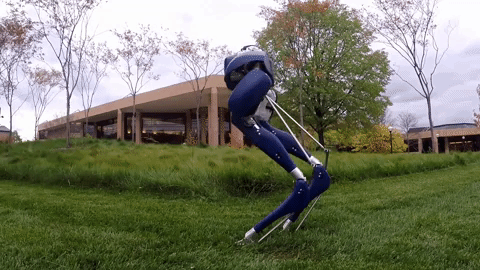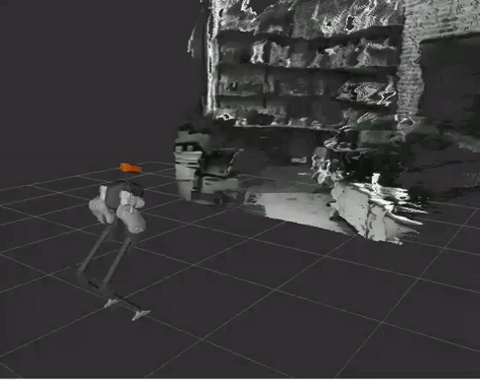Our ultimate goal is to have Cassie (and other legged robots) autonomously navigating across unknown and previously unmapped terrain, all while maintaining stability. In order to handle large terrain disturbances and to allow for path planning, a real-time map of the environment needs to be built. In this project, we are working on various state estimation methods that fuse together sensor measurements coming from IMUs, contact sensors, joint encoders, LiDARs, and stereo cameras to estimate the robot's state. As Cassie Blue moves through the environment, these estimators will give us the robot's path, allowing a terrain map to be built. Eventually, we aim to incorporate this terrain information into the feedback controller, improving the robot's stability over rugged terrain.

Cassie Blue is our newest robot family member in the lab. She was conceived by Agility Robotics. Five motors on each leg enable her to walk, stand and turn as well as a human, or if our control designs go well, maybe even better! Cassie Blue serves as a testbed to inspire and verify our mathematics, which we hope is valid for an large gamut of bipedal machines. Our goal is to design control strategies that allow a bipedal robot to conquer diverse terrains, such as snow, rocks and stairs, and in general, to go where the wheels cannot.
Exoskeletons

Past Projects
Marlo
MARLO, which stands for Michigan Anthropomorphic Robot for Locomotion Outdoors, was our initial foray into the world of 3D bipedal locomotion, that is, she was our first robot that did not use a bar to prevent it from falling sideways. Each of MARLO's legs has 3 actuators: one for the knee, one at the hip for moving the leg forward or backward, and a second one at the hip to move the leg sideways. This challenging robot led us to create some amazing control theory for gait design in 3D. You can find this work in the publication section.
Mabel
MABEL, which stands for Michigan Anthropomorphic Biped with Electric Legs, features a compliant powertrain. The robot was constructed in collaboration with Jonathan Hurst when he was a Ph.D. student of the Robotics Institute at Carnegie Mellon. MABEL was designed to run! And run she did! MABEL's legs include springs for energy storage; they act somewhat like tendons in the human body. You can read about MABEL in this Control Systems Magazine Article.
Rabbit
Rabbit is where it all started. We performed extensive analysis and experiments on this exciting and---at the time---highly iconoclastic machine--- from 1999 through 2004. It is a rigid, five-link, four-actuator, planar bipedal robot based in Grenoble, France. It was conceived for the study of underactuation in walking. This robot inspired Grizzle and colleagues to develop a novel paradigm for control law design which broke cleanly away from the flat-footed (fully-actuated) assumptions of previous work and yet combined analytical tractability with the ability to treat realistic models. You can read about Rabbit in this Control Systems Magazine Article and you can see videos of Rabbit in action on our YouTube Channel . This robot led to a coherent theory of walking for underactuated robots.







